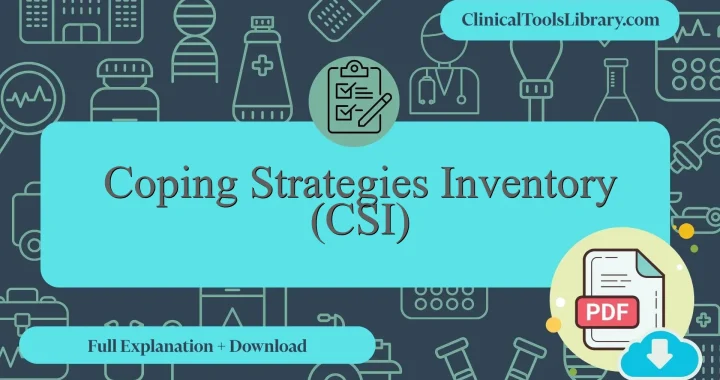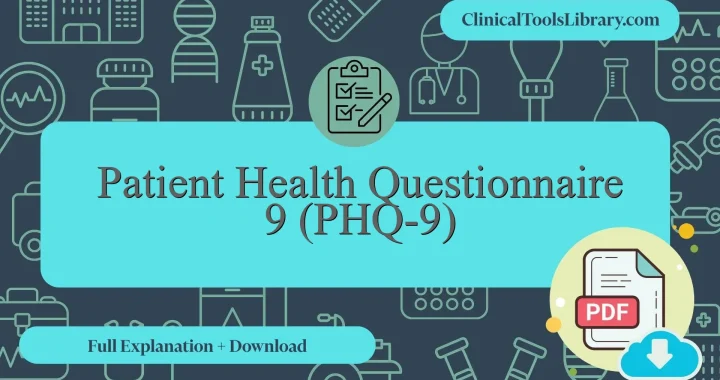In this article, we explain everything you need to know about the Child Trauma Screening Questionnaire. We will cover the aspects it evaluates, the target population, a detailed step-by-step explanation, and how to interpret its results. Additionally, we will dive into the scientific evidence supporting this tool (diagnostic sensitivity and specificity) in clinical assessment. You will also find official and unofficial sources available for download in PDF format.
What does the Child Trauma Screening Questionnaire assess?
The Child Trauma Screening Questionnaire (CTSQ) is a standardized tool designed to identify symptoms related to post-traumatic stress disorder (PTSD) and other trauma-related conditions in children and adolescents. Its primary objective is to facilitate early detection of traumatic stress responses following exposure to potentially distressing events, enabling timely intervention. The CTSQ evaluates key domains including intrusive thoughts, avoidance behaviors, and heightened arousal. Versions such as the Child and Adolescent Trauma Screen (CATS) and its caregiver report complement the screening process by providing comprehensive assessment across different informants. The questionnaire is available in various formats including the Child Trauma Screening Questionnaire PDF, supporting ease of administration and scoring, and aligns with other tools like the Trauma Screening Questionnaire for Youth and the Childhood Trauma Screening Questionnaire for Adults to ensure continuity in trauma assessment across age groups.
For which type of patients or populations is the Child Trauma Screening Questionnaire intended?
The Child Trauma Screening Questionnaire is primarily indicated for use with children and adolescents who have been exposed to potentially traumatic events, including abuse, neglect, domestic violence, and community violence. It is most useful in clinical contexts such as pediatric mental health services, emergency departments, and school-based health programs where early identification of trauma-related symptoms is critical. This tool facilitates rapid screening to determine the need for further assessment or intervention. Clinicians commonly utilize the Child and Adolescent Trauma Screen (CATS) and its variants, including the Child and Adolescent Trauma Screen Caregiver Report, to gather comprehensive information from multiple informants, enhancing diagnostic accuracy. Its application supports evidence-based decision-making in trauma-focused treatment planning, particularly in settings requiring standardized symptom evaluation and risk stratification.
Step-by-Step Explanation of the Child Trauma Screening Questionnaire
The Child Trauma Screening Questionnaire (CTSQ) consists of 10 items designed to identify symptoms of post-traumatic stress disorder in children aged 7 to 16. Each question addresses various symptom clusters, including re-experiencing, hyperarousal, and avoidance behaviors. The response format is binary, requiring caregivers or children to select “yes” or “no” for each item, enabling a straightforward scoring process. To administer the CTSQ accurately, the practitioner should read each question aloud in a neutral tone, ensuring comprehension, and record responses systematically. A total score of 5 or more suggests the need for further clinical evaluation.
Child Trauma Screening Questionnaire PDF: Download Original & English Version Resources
Downloadable resources for the Child Trauma Screening Questionnaire PDF are available below, including both the original language version and the English translation. These documents support accurate assessment by providing standardized tools essential for the identification of trauma-related symptoms in children and adolescents. The availability of these files facilitates clinicians’ access to the Child and Adolescent Trauma Screen pdf, ensuring consistency in administration and scoring across diverse settings.
How to interpret the results of the Child Trauma Screening Questionnaire?
The Child Trauma Screening Questionnaire (CTSQ) results are interpreted by comparing the total score against established reference values, with scores above the clinical cutoff of 5 indicating a significant likelihood of post-traumatic stress symptoms. The total score is calculated by summing affirmative responses to the 10 items. For example, a child scoring 6 or higher may require further diagnostic assessment and intervention. Practically, healthcare professionals use these results to identify children at risk for trauma-related disorders and to prioritize timely referral for specialized psychological evaluation or treatment, facilitating early intervention strategies that can mitigate long-term adverse effects.
What scientific evidence supports the Child Trauma Screening Questionnaire ?
The Child Trauma Screening Questionnaire (CTSQ) was developed in the late 1990s to provide a brief, efficient tool for early identification of post-traumatic stress disorder (PTSD) symptoms in children following exposure to traumatic events. Validation studies have demonstrated strong psychometric properties, including high sensitivity and specificity, when compared to structured clinical interviews such as the Clinician-Administered PTSD Scale for Children and Adolescents (CAPS-CA). Research published in peer-reviewed journals has confirmed the CTSQ’s reliability across diverse populations, showing robust internal consistency and construct validity. Longitudinal data indicate that early screening with the CTSQ effectively predicts subsequent development of PTSD, facilitating timely intervention and improving clinical outcomes. Its widespread adoption in pediatric emergency and mental health settings underscores its utility as an evidence-based instrument for trauma assessment.
Diagnostic Accuracy: Sensitivity and Specificity of the Child Trauma Screening Questionnaire
The Child Trauma Screening Questionnaire (CTSQ) demonstrates a reported sensitivity ranging from 0.85 to 0.90 in identifying children with significant symptoms of post-traumatic stress disorder (PTSD) following exposure to traumatic events. The specificity of the CTSQ typically lies between 0.70 and 0.80, indicating a moderate ability to correctly exclude children without clinically significant trauma-related symptoms. These values reflect the CTSQ’s utility as an initial screening tool in clinical and emergency settings, allowing for timely identification of at-risk pediatric populations while balancing the risks of false positives and negatives. The instrument’s psychometric properties have been validated across diverse pediatric cohorts, supporting its role in early assessment protocols for trauma-exposed children and adolescents.
Related Scales or Questionnaires
The Child Trauma Screening Questionnaire shares similarities with several instruments such as the Child and Adolescent Trauma Screen (CATS), the Trauma Screening Questionnaire for Youth, and the Childhood Trauma Screening Questionnaire for Adults. Each of these tools, detailed on ClinicalToolsLibrary.com, offers distinct advantages; for instance, the CATS provides a comprehensive assessment of symptomatology aligned with DSM-5 criteria, enhancing diagnostic precision, while the Trauma Screening Questionnaire for Youth allows rapid identification of trauma exposure in clinical settings. However, limitations exist, such as variability in sensitivity and specificity across populations and the need for caregiver input in some versions, which may impact reliability. The availability of the Child Trauma Screening Questionnaire PDF and scoring guides on the website facilitates standardized administration and interpretation, supporting clinicians in selecting the most suitable measure according to patient age and context. These scales, also thoroughly explained online, contribute valuable options for trauma assessment in both research and practice.




